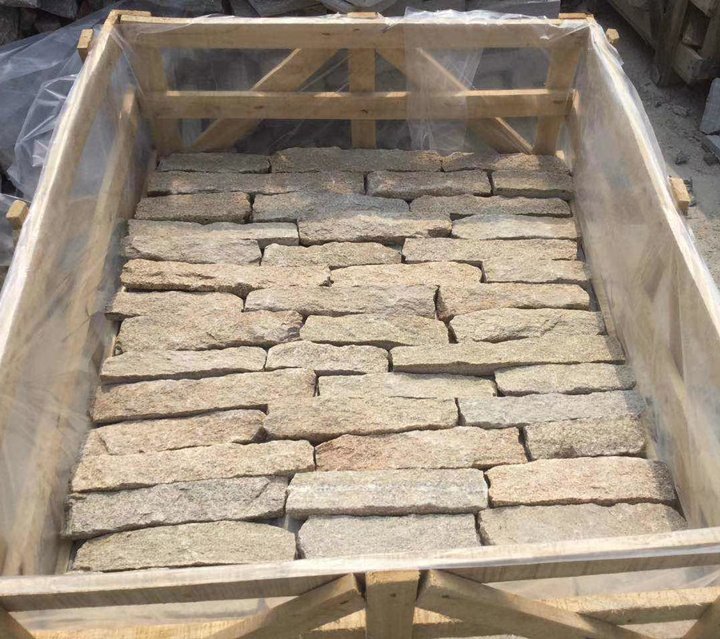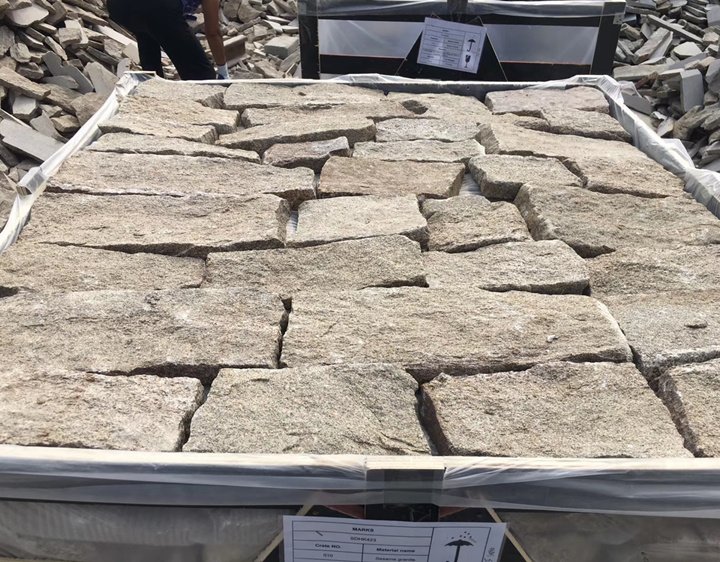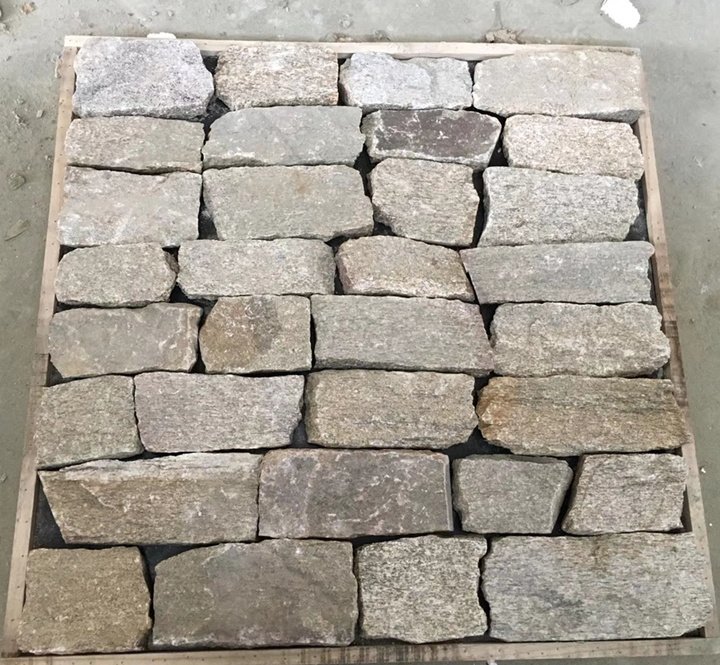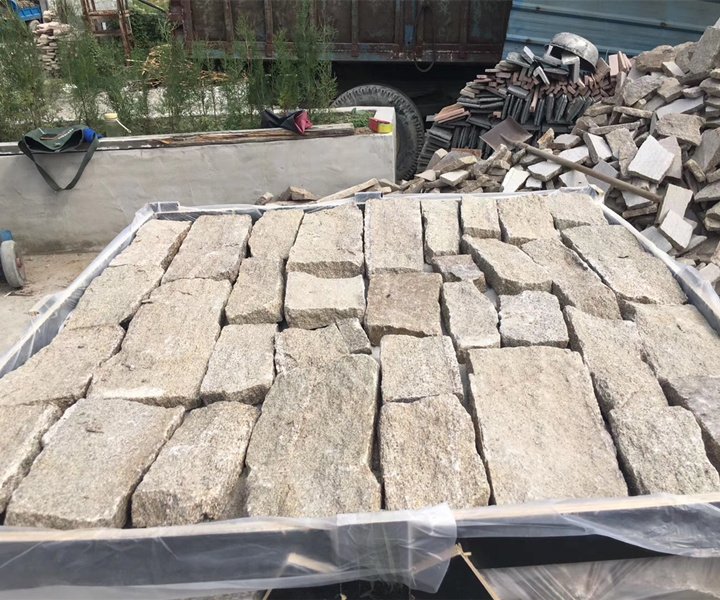Yellow Quartzite Loose Ledgestone Veneer Dry Stack Cladding is a natural quartzite strip stone cut into linear ledgestone pieces for hand-laid dry stack installations. The stone ranges in warm yellow, gold, beige, and soft earth tones with subtle variation and natural split-face texture that creates depth and shadow on the wall.
Each piece is sawn or calibrated on the back for strong adhesion while the face remains split and rugged for a true ledgestone look. The loose format gives masons the freedom to blend lengths and heights on site, creating a bespoke, high-end finish that pre-assembled panels cannot match.
Application Showcase
Yellow quartzite loose ledgestone works on both exterior and interior vertical surfaces, including full building facades, feature walls, and entry surrounds. Architects and designers use it to add warmth and texture to modern exteriors, mixed-material facades with stucco or metal, and hospitality or retail elevations.
In residential settings, the stone is ideal for:
- Fireplaces, TV feature walls, and wine rooms
- Kitchen accent walls and stairwell walls
- Outdoor garden walls, retaining walls, and planters
- Outdoor kitchens, pool feature walls, and columns
The loose ledgestone format supports both tight dry stack and pointed mortar-joint aesthetics, depending on project design and regional style. Distributors can position the line for use in single-family, multi-family, hospitality, and light commercial projects.
Package Method
Loose yellow quartzite ledgestone veneer is supplied in standardized export wooden or plywood crates suitable for container loading. Pieces are hand packed by size mix, with protective inner packing to control breakage and maintain consistent yield per square meter.
A typical crate configuration carries approximately 10–15 m² (about 107–161 ft²) of loose quartzite strips, with average crate weights near 60–70 kg per m² depending on thickness. Crates are banded and plastic-wrapped, labeled with product code, color, size range, and batch for traceability in distributor yards.
Supply is optimized for full 20-foot or 40-foot containers, which can be loaded with multiple colorways or size mixes if required by the customer. Consistent packing specifications help buyers forecast freight costs per square foot and plan warehouse storage and handling.
The Core B2B Value Proposition
For distributors and importers, yellow quartzite loose ledgestone delivers a high-margin natural stone line that competes directly with modular panels while offering a more custom, mason-driven appearance. The product category has strong, sustained demand in both new construction and remodeling.
- Quality & Durability: Quartzite’s durability and color stability reduce warranty risk and callbacks, supporting long-term relationships with trade customers and builders.
- Reliable Supply: Reliable crate packing, size calibration, and quality control across batches give B2B buyers confidence to commit to stocking programs and repeat container orders.
- Flexibility for Masons: For contractors, the loose format offers flexibility to handle on-site conditions, wall irregularities, and custom details without being constrained by fixed panel sizes.
Technical & Logistics Specifications
Yellow quartzite ledgestone veneer is produced from natural quartzite blocks selected for color consistency in yellow and golden tones. The material features a natural split-face texture on the front, sawn or calibrated back, and sawn or split ends.
- Material: Natural Quartzite
- Format: Individual Loose Strips (Flats & Corners)
- Finish: Natural Split Face, Sawn/Calibrated Back
- Piece Sizes: Random lengths (approx. 150–400 mm), Widths (approx. 60–200 mm), Thickness (approx. 20–35 mm).
- Weight (avg): 65 kg per m² (13-15 lb per sq ft)
- Performance: High compressive strength, low porosity, excellent freeze-thaw resistance.
- Packaging: Export-ready wood or plywood crates (approx. 10-15 m² per crate).
- Logistics: Optimized for full 20ft or 40ft containers.
Installation Benefits for Contractors
Loose ledgestone veneer gives installers more control than pre-assembled panels because they can select each piece to manage color balance, joints, and transitions. Random lengths and varied heights reduce repetitive patterns, which helps contractors deliver a custom-looking wall with a premium appearance.
The sawn or calibrated back improves contact with the substrate, which supports bond strength and speeds troweling and setting. Because the pieces are a veneer thickness rather than full bed-depth stone, they are lighter to handle and can be used on framed walls with suitable substrates.
Manufacturing & Quality Control
Production starts with selection of quartzite blocks or slabs that meet color and structural standards for yellow and golden tones. The stone is processed into strips by sawing and splitting, creating a split-face texture on the front and controlled thickness across the piece.
Each batch is checked for size range, thickness tolerance, and color grouping so that crates deliver a usable mix to the jobsite. Edges and backs are monitored to support safe handling, proper adhesion, and good alignment when hand-laid by masons. During packing, workers inspect pieces for defects. A dedicated inspection team oversees quarry selection, production, packing, and container loading.
















